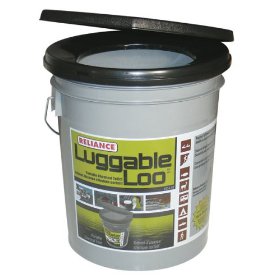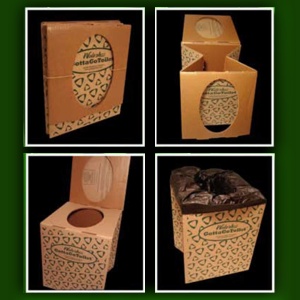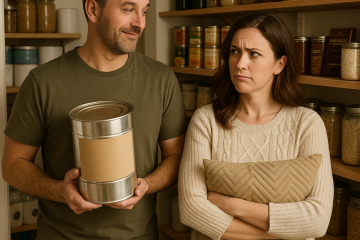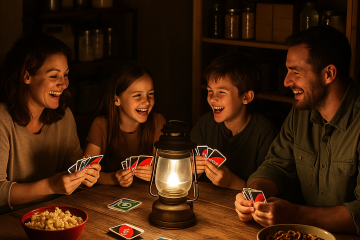 Sanitation is one of the ten critical components of emergency preparedness. In my book, it is usually one of the top two that are most overlooked. A lot of us take emergency sanitation for granted until our toilet breaks down or the sewer backs up. Keep in mind, if there is a quarantine, who’s going to maintain the proper working order of the sewage services? If there’s a financial collapse, how will we even have the wherewithal to send our waste somewhere else? If you don’t take emergency sanitation seriouslythen the consequences can be extremely dire—even up to a 50 mile radius. Preventing waste from contaminating the soil is just as important as preventing the spread of any other disease as it contaminates crops, water, and air. Additionally, as water will be scarce in a time of emergency, ensuring that it does not get contaminated with improper sanitation habits is critical.
Sanitation is one of the ten critical components of emergency preparedness. In my book, it is usually one of the top two that are most overlooked. A lot of us take emergency sanitation for granted until our toilet breaks down or the sewer backs up. Keep in mind, if there is a quarantine, who’s going to maintain the proper working order of the sewage services? If there’s a financial collapse, how will we even have the wherewithal to send our waste somewhere else? If you don’t take emergency sanitation seriouslythen the consequences can be extremely dire—even up to a 50 mile radius. Preventing waste from contaminating the soil is just as important as preventing the spread of any other disease as it contaminates crops, water, and air. Additionally, as water will be scarce in a time of emergency, ensuring that it does not get contaminated with improper sanitation habits is critical.
High amounts of hydrogen sulfide results from human waste. It not only smells horrible but can also be very dangerous if a great deal of build-up occurs locally. Flies, rodents, and other unwelcome “guests” are attracted to the smell of fecal matter. Flies actually consume it. Unfortunately, this also means that human waste is speedily spread to humans via flies and rodents to multiple locations and can subsequently affect an entire community with a sanitation disaster within 48 hours. Thus ensuring that your toilets are covered and you have the ability to break down the waste is critical in order to ensure the best health in a stressful circumstance.
Your first line of defense for emergency sanitation will still be the toilet in your own home—for a little while at least. You may only have enough time to build an alternative source, but you should at least have some time to implement these initial strategies. So long as you have water supply and flush conservatively. When you aren’t able to flush any longer, plan on pouring water down the toilet to get rid of the waste. (Think how fast you’ll be using that water folks. Now do you start to see why I say a gallon per person, per day is the minimum amount you want to store? Although, keep in mind, you can use dish water, laundry water, or leftover cooking water for this purpose.) After you no longer have this option, plan on using the toilet as more of a “bucket.” Turn off all of the water to the toilet, and then plug it up with a tennis ball to ensure that no sewage comes through. Then line your toilet with a bio-degradable, compostable bag. When you’ve exhausted the use of that bag, seal it, and then bury it so it will decompose properly.
In the eventual likelihood that you will have to move your “outhouse” outdoors, there are several additional considerations for emergency sanitation. Obviously, you want to keep it away from any food or water supply. But you will want to be sure that you have chlorinated lime or bleach on hand to chemically and safely break down the waste matter. (Note: Powdered, chlorinated lime is available at building supply stores and it can be used dry. Be sure to get chlorinated lime and not quick lime, which is highly alkaline and corrosive.)
Every single time a person uses the toilet, some type of disinfectant should be sprinkled on top. It can be chlorinated lime, bleach, or even some other household disinfectants such as Pinesol, Lysol Cleaner, Arm & Hammer cleaners, plain baking soda, laundry detergent, etc. (All of which, by the way, I’ve obtained for dirt cheap lately using my coupon strategies.) Remember, regardless of the smell or condition of your toilet area, it should always be kept well covered for emergency sanitation. Don’t use DRY bleach. It can eat away at your bags and containers.
We have a few options on hand in our home in addition to the indoor toilet. We have a 5-gallon bucket that has a “toilet lid” which fits securely on top. If you’re going to use the bucket method, I recommend you line it with a garbage bag, then fill it with about ¾ a gallon of water with one cup of liquid chlorine bleach. This will help in breaking down the smell and the waste immediately upon use. (I have a lot of Acco clips stored to help ensure that the plastic bags stay in place.) When the bucket is about half full (no more) seal off the bag and bury it properly. If you have babies in diapers, be sure to store their used diapers in this bag as well and dispose of accordingly.
We also have a “Gotta Go” potty from ChemiSan. We’re sure to also have plenty of garbage bags, plastic gloves, and disinfectants available. What good is making a great meal if the aroma is overwhelmed by the nausea you feel as a result of the pervasive stench of sanitation problems? I actually highly recommend the ChemiSan products. (Do an internet search to find a dealer near you.) They are truly amazing in ensuring proper sanitation. The ChemiSan company has portable toilets made of cardboard, ideal bags for the disposal of waste, and of course, their ChemiSan powder product that actually consumes the human waste in a matter of hours, neutralizing the odors so that flies and other rodents aren’t attracted to the waste area. (This powder can be obtained in small, individual packages—ideal for camping as well.)
In addition to the human waste aspect of emergency sanitation, be sure that you consider the most sanitized way of disposing of your regular garbage. If you drain your garbage of all liquid, it can be stored longer. Obviously, the ability to burn your garbage is ideal. Both garbage and human waste should be buried no less than 12 inches deep in the ground, preferably 18 to 24 inches.
Perhaps not so obvious to some is to ensure that you are constantly keeping your hands clean. Typhoid fever, amoebic dysentery, diarrhea, infectious hepatitis, salmonella and giardia are diseases that spread rapidly in times of emergency and threaten the lives of all of those around you. Yet these are all diseases that can easily be controlled by simply following the rules of good sanitation.
Along these same lines of emergency sanitation, do you even know how much toilet paper your family goes through in a week so you can plan accordingly? If not, then the next time you put a new roll of t.p. on, use a Sharpie and mark the date on the inside of the roll that you’re putting it on. Then when it’s empty, check the date and you’ll eliminate the guessing. In my opinion, you can never have too much toilet paper, especially for emergency sanitation.
To see our upcoming event schedule, click here
Check out our inhome-course programs
Subscribe to Preparedness Pro today and never miss a thing!
For any questions or comments on this article, please leave a comment on the blog site so that everyone can benefit!
Copyright Protected 2009, Preparedness Pro and Kellene. All Rights Reserved. No portion of any content on this site may be duplicated, transferred, copied, or published without written permission from the author. However, you are welcome to provide a link to the content on your site or in your written works.






24 Comments
Angela DiGiovanni · July 27, 2009 at 6:24 pm
It is not a bad idea to have a bottle of Thieves Oil on hand, too, as it has been University (Weber State) tested to kill 99.6% of all airborne bacteria.
Thanks for the great info!
Angela DiGiovanni · July 27, 2009 at 6:24 pm
It is not a bad idea to have a bottle of Thieves Oil on hand, too, as it has been University (Weber State) tested to kill 99.6% of all airborne bacteria.
Thanks for the great info!
Kellene · July 27, 2009 at 6:28 pm
I agree Angela. I’ve got mine ordered!
Kellene · July 27, 2009 at 6:28 pm
I agree Angela. I’ve got mine ordered!
Kris · July 28, 2009 at 2:42 am
During Ike, our toilets almost flooded. There was so much water in the streets and drains that we could not flush for about a day. Even if you had water, and we had PLENTY outside…. there were no clear drains to flush into. The street in front of our house was flooded and the backyard was borderline. I don’t ever want to be caught like this again. I can see how disease can spread so quickly.
Kris · July 28, 2009 at 2:42 am
During Ike, our toilets almost flooded. There was so much water in the streets and drains that we could not flush for about a day. Even if you had water, and we had PLENTY outside…. there were no clear drains to flush into. The street in front of our house was flooded and the backyard was borderline. I don’t ever want to be caught like this again. I can see how disease can spread so quickly.
Believer · July 28, 2009 at 7:33 pm
Another thing that works well in your Luggable Loo, or portible toilet, is kitty litter, and it’s not very expensive. It will absorb fluids help with odors. It’s also a good thing to have during a pandemic.
Get a 2 liter bottle and fill it with the kitty litter, and store it in your “honey bucket” ready to go if you have to leave suddenly.
Believer · July 28, 2009 at 7:33 pm
Another thing that works well in your Luggable Loo, or portible toilet, is kitty litter, and it’s not very expensive. It will absorb fluids help with odors. It’s also a good thing to have during a pandemic.
Get a 2 liter bottle and fill it with the kitty litter, and store it in your “honey bucket” ready to go if you have to leave suddenly.
Kris · July 29, 2009 at 1:06 am
Do you bury the kitty litter too?
Kris · July 29, 2009 at 1:06 am
Do you bury the kitty litter too?
Believer · July 29, 2009 at 4:51 am
Yes. You most definately do.
Believer · July 29, 2009 at 4:51 am
Yes. You most definately do.
Kellene · July 29, 2009 at 5:20 am
I would definitely not recommend the kitty litter. It does not dispose well. Think about this. It’s one thing for cats to use it, it’s another for millions of millions of Americans to use it with their much larger bowels etc for at least a year. Kitty litter will work in a pinch, but I would recommend using items that decompose much faster. Remember, an emergency could be long term.
Kellene · July 29, 2009 at 5:20 am
I would definitely not recommend the kitty litter. It does not dispose well. Think about this. It’s one thing for cats to use it, it’s another for millions of millions of Americans to use it with their much larger bowels etc for at least a year. Kitty litter will work in a pinch, but I would recommend using items that decompose much faster. Remember, an emergency could be long term.
Believer · July 29, 2009 at 8:21 am
I was not meaning to use it for a year—-only for use temporarily along with our 72 hour kits, or temporary water shut off. I have enough problems trying to find enough places to put my years supply. I certainly don’t have enough room for a years supply of kitty litter.
Believer · July 29, 2009 at 8:21 am
I was not meaning to use it for a year—-only for use temporarily along with our 72 hour kits, or temporary water shut off. I have enough problems trying to find enough places to put my years supply. I certainly don’t have enough room for a years supply of kitty litter.
Believer · July 29, 2009 at 8:49 am
I have a Luggable Loo like the one pictured above, except mine is green. In it I have a plastic garbage bag. In the garbage bag, I have a box of garbage bags, several rolls of toilet paper, hand moisture wipes, a liter bottle of kitty litter, paper towels, and packs of enzyme deodorizer. After using this, an outhouse would be a luxury.
Believer · July 29, 2009 at 8:49 am
I have a Luggable Loo like the one pictured above, except mine is green. In it I have a plastic garbage bag. In the garbage bag, I have a box of garbage bags, several rolls of toilet paper, hand moisture wipes, a liter bottle of kitty litter, paper towels, and packs of enzyme deodorizer. After using this, an outhouse would be a luxury.
Michele · April 4, 2013 at 1:37 am
How would use use the “Thieves” oil to catch airborne bacteria? Do you just leave an open bottle of oil around or pour some in dish?
Michele · April 4, 2013 at 1:37 am
How would use use the “Thieves” oil to catch airborne bacteria? Do you just leave an open bottle of oil around or pour some in dish?
Michele · April 4, 2013 at 1:39 am
Wondering how much Chlorinated Lime you would use in a porta potty? Just sprinkle a 1/2 cup or so each time you use the potty? Do you also use it in the hole where you bury your 1/2 full garbage bag? Also how far away from a well or stream or other water source should you bury waste? Isn’t there a threat of ground water contamination?
Michele · April 4, 2013 at 1:39 am
Wondering how much Chlorinated Lime you would use in a porta potty? Just sprinkle a 1/2 cup or so each time you use the potty? Do you also use it in the hole where you bury your 1/2 full garbage bag? Also how far away from a well or stream or other water source should you bury waste? Isn’t there a threat of ground water contamination?
Kellene Bishop · April 4, 2013 at 2:12 am
Well, if you’re stuck with Thieves Essential Oil, this would be one of the few things I’d use it on. I’d simply sprinkle it after each use–A LOT of it, as it’s not nearly concentrated enough with the proper active constituents to take care of the bacteria properly with just a drop. So I’d use several drops.
Kellene Bishop · April 4, 2013 at 2:12 am
Well, if you’re stuck with Thieves Essential Oil, this would be one of the few things I’d use it on. I’d simply sprinkle it after each use–A LOT of it, as it’s not nearly concentrated enough with the proper active constituents to take care of the bacteria properly with just a drop. So I’d use several drops.
Comments are closed.